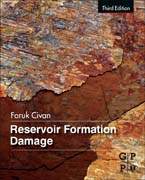
Reservoir Formation Damage, Third Edition, provides the latest information on the economic problems that can occur during various phases of oil and gas recovery from subsurface reservoirs, including production, drilling, hydraulic fracturing, and workover operations. The text helps readers better understand the processes causing formation damage and the factors that can lead to reduced flow efficiency in near-wellbore formation during the various phases of oil and gas production. The third edition in the series provides the most all-encompassing volume to date, adding new material on conformance and water control, hydraulic fracturing, special procedures for unconventional reservoirs, field applications design, and cost assessment for damage control measures and strategies. Understand relevant formation damage processes by laboratory and field testingDevelop theories and mathematical expressions for description of the fundamental mechanisms and processesPredict and simulate the consequences and scenarios of the various types of formation damage processes encountered in petroleum reservoirsDevelop methodologies and optimal strategies for formation damage control and remediation INDICE: Preface Ch 1: Overview of Formation Damage Part I: Fundamentals Ch 2: Formation Damage Potential of Oil and Gas Reservoirs: Conventional Versus Unconventional Ch 3: Mineralogy and Mineral Sensitivity of Petroleum-Bearing Formations Ch 4: Petrography and Texture of Petroleum-Bearing Formations Ch 5: Petrophysics: Flow Functions, Permeability Relationships, and Parameters Part II: Formation Damage Processes Ch 6: Single-Phase Fines Migrations Ch 7: Multi-Phase Fines Migration Ch 8: Crystal Growth and Scale Formation Ch 9: Inorganic Scaling and Geochemical Damage Ch 10: Organic Deposition Ch 11: Naphthenate Deposition Ch 12: Sulphur Deposition Ch 13: Wellbore Fluids, Polymers and Gels Ch 14: Conformance and Water Control Ch 15: Completion and Workover Fluids Ch 16: Cementing Ch 17: Hydraulic Fracturing Ch 18: Drilling Mul Filtrate and Solids Invasion and Mudcake Formation Ch 19: Injection Wells Damage: Characterization Injectivity of the Waterflooding Wells Ch 20: Vertical, Horizontal, and Multilateral Drilling Ch 21: Reservoir Sand Migration and Gravel-Pack Damage: Stress-Induced Damage, Sanding Tendency, Prediction and Control Ch 22: Thermal Processes Part III: Formation Damage Testing and Determination Ch 23: Instrumental and Laboratory Techniques for Characterization of Reservoir Rocks Ch 24: Laboratory Evaluation of Formation Damage Ch 25: Simulator Development Ch 26: Model Assisted Analysis and Interpretation of Laboratory and Field Tests Ch 27: Field Diagnosis and Measurement of Formation Damage Ch 28: Determination of Formation-and Pseudo-Damage from Well Performance: Indication, Characterization, Evaluation, and Abatement Part IV: Formation Damage Mitigation Ch 29: Reservoir Formation Damage Abatement: General Guidelines, Methodology, Preventive Maintenance, and Remediation Treatments Ch 30: Special Procedures for Conventional Reservoirs Ch 31: Special Procedures for Unconventional Reservoirs Ch 32: Formation Damage Control and Remediation Ch 33: Field Applications Design and Cost Assessment for Damage Control Measures and Strategies
- ISBN: 978-0-12-801898-9
- Editorial: Gulf Professional Publishing
- Encuadernacion: Cartoné
- Páginas: 920
- Fecha Publicación: 01/06/2015
- Nº Volúmenes: 1
- Idioma: Inglés
